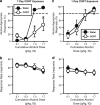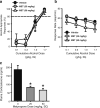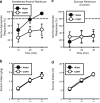The effects of repeated corticosterone exposure on the interoceptive effects of alcohol in rats
- PMID: 22016195
- PMCID: PMC3422726
- DOI: 10.1007/s00213-011-2533-8
The effects of repeated corticosterone exposure on the interoceptive effects of alcohol in rats
Abstract
Rationale and objective: Repeated and/or heightened elevations in glucocorticoids (e.g., repeated stress) can promote escalated drug-taking behaviors and induce compromised HPA axis function. Given that interoceptive/subjective drug cues are a fundamental factor in drug-taking behavior, we sought to determine the effects of exposure to repeated elevations in the glucocorticoid corticosterone (CORT) on the interoceptive effects of alcohol in rats using drug discrimination techniques.
Methods: Male Long Evans rats trained to discriminate alcohol (1 g/kg, IG) vs. water were exposed to CORT (300 μg/ml) in the home cage drinking water for 7 days. The interoceptive effects of experimenter- and self-administered alcohol were assessed and HPA axis function was determined.
Results: The interoceptive effects of experimenter- and self-administered alcohol were blunted following CORT. Control experiments determined that this decreased sensitivity was unrelated to discrimination performance impairments or decreased CORT levels at the time of testing and was dependent on repeated CORT exposure. Susceptibility to compromised HPA axis function following CORT exposure was suggested by an altered pattern of CORT secretion and blunted CORT response following injection of the synthetic glucocorticoid dexamethasone.
Conclusions: These findings present a possible behavioral mechanism for escalated alcohol drinking during episodes of heightened elevations in glucocorticoids (e.g., stress). That is, during these episodes, individuals may consume more alcohol to achieve the desired interoceptive effects. Understanding these behavioral mechanisms may lead to a better understanding of factors that promote alcoholism and alcohol abuse in at risk populations.
Figures




References
-
- Adinoff B, Martin PR, Bone GH, Eckardt MJ, Roehrich L, George DT, Moss HB, Eskay R, Linnoila M, Gold PW. Hypothalamic–pituitary–adrenal axis functioning and cerebrospinal fluid corticotropin releasing hormone and corticotropin levels in alcoholics after recent and long-term abstinence. Arch Gen Psychiatry. 1990;47:325–330. - PubMed
-
- Berman JD, Cook DM, Buchman M, Keith LD. Diminished adrenocorticotropin response to insulin-induced hypoglycemia in nondepressed, actively drinking male alcoholics. J Clin Endocrinol Metab. 1990;71:712–717. - PubMed
-
- Besheer J, Cox AA, Hodge CW. Coregulation of ethanol discrimination by the nucleus accumbens and amygdala. Alcohol Clin Exp Res. 2003;27:450–456. - PubMed
Publication types
MeSH terms
Substances
Grants and funding
LinkOut - more resources
Full Text Sources

